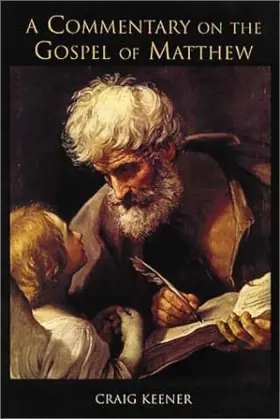

Matthew
Pages
1040
Publisher
Eerdmans
Published
1/1/1999
ISBN-13
9780802838216
Collections
This book appears in the following featured collections.
- Nijay Gupta's Top NT Commentaries by Nijay K. Gupta
Reviews
Keener’s work receives high recommendations and significant warnings about the limits of its usefulness. It may also be going out of print since it is not available at Westminster Books and is currently available only from Amazon resellers. This is the kind of commentary I tend to avoid since I don’t consider myself sufficiently schooled to confidently sort through the weaknesses. However, most experts do recommend it with certain caveats.
[Full Review]
Craig S. Keener’s study (Eerdmans, 1999) is marked by his particular interest in the socio-historical contexts of the first Evangelist and his first-century audience, combined with pericope-by-pericope suggestions regarding the nature of Matthew’s exhortations to his predominately Jewish Christian audience.
[Full Review]
Well laid out, easy to follow, lots of historical background (with a long bibliography and plenty of footnotes and references). Good for preaching, teaching, and academic research. See my detailed review at the following link.
[Full Review]
I am preaching through Matthew and have extensively used a number of commentaries. Of all of the commentaries on Matthew, this is the most interesting - but not necessarily the most helpful. The scope of work is amazing and at times, it is so incredibly detailed. Yet, there are a few sections that I didn't find useful at all (odd when considering the detail scope of the entirety of the work - I guess he had to limit his work is some places) and I just put the work back on the shelf. He does a great job of outlining Matthew and placing the information in beneficial clumps. His writing might be the best and most readable of all of the commentaries on Matthew.
Like France and Carson, Keener is an outstanding exegete. His commentary is distinctive in its emphasis on the social-historical context of the Gospel. It also contains a very useful 150 page bibliography of secondary resources on the Gospel of Matthew.
[Full Review]
During the 1960’s and 70’s there was a dearth of up-to-date, comprehensive commentaries on Matthew suitable for academic work with advanced seminary and college students. The new wave began with Robert Gundry in 1982, followed by the 3-volume commentary by W. D. Davies and D. C. Allison and D. Hagner’s 2-volume contribution. (Unfortunately, only one volume of U. Luz’s excellent commentary has been made available in English; the second volume is promised for November, 2000.) Now, at the turn of the century, Craig Keener has produced a careful, 1000-page academic commentary that will be very useful for Matthew seminars, although its high price will keep many students from buying it. In the Introduction Keener states his intention: to provide an analysis of the socio-historical contexts of Matthew and of his traditions, and unit-by-unit suggestions about the evangelist’s exhortations (with proposals concerning their modem relevance). Because of his concern for the literary and historical context, he is assiduous in providing references to Greco-Roman literature where parallels exist, even though he very often concludes that the parallels are too remote to be relevant. References to contemporary Jewish sources and later rabbinic literature are also extensive. Keener regards the evangelist as a Diaspora biographer who is influenced by contemporary pagan models. Matthew, he argues, is conservative in his use of his sources; the burden of proof rests on those who deny the historical authenticity of the Gospel’s contents. He is inclined to ascribe the Gospel to the disciple Matthew, but concedes that certainty is impossible. He favors a date after 70 C.E.
[Full Review]
This commentary comes on the heels of Keener’s pneumatological study (The Spirit in the Gospels and Acts: Divine Purity and Power. Peabody, MA: Hendrickson Publishers, 1997) and his commentary for pastors and church leaders (Matthew, InterVarsity Press New Testament Commentary Series. Downers Grove, IL: InterVarsity Press, 1997). Readers of those works will discover that much of the material has found its way into this present work. The commentary examined here is an enlarged academic version of the IVP commentary. The outline is the same, the introductory issues addressed are very similar, and the comments are an expansion of that which is found in the earlier work. The focus of the commentary is twofold: 1) to examine the social-historical contents of Matthew and his traditions, and 2) to provide commentary on the nature of Matthew’s exhortations to his readers. Following Burridge (R. A. Burridge, What are the Gospels? A Comparison with Graeco-Roman Biography. SNTSMS 70. Cambridge: Cambridge University Press, 1992), he views the First Gospel as ancient biography, written to acquaint the readers with the character of Jesus through his words and deeds, providing the example for them to follow. He notes that the writer of Matthew takes great freedom in the arrangement and emphases of his sources (Mark and Q), but stays true to the tradition he has received. The focus of the commentary is twofold: 1) to examine the social-historical contents of Matthew and his traditions, and 2) to provide commentary on the nature of Matthew’s exhortations to his readers. Following Burridge (R. A. Burridge, What are the Gospels? A Comparison with Graeco-Roman Biography. SNTSMS 70.
[Full Review]





